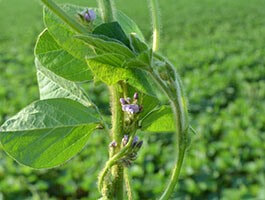Managing White Mold
Jun 11, 2018

In Agtegra’s trade territory, soybeans are an economical crop. However, soybeans have a risk of being hit with white mold, a damaging fungus that is essentially incurable once in the plant.
All soybeans are susceptible to white mold, although there are some varieties that are more tolerant.
“There are many areas of our territory that have been hit hard the past few years,” Ruden adds. “The areas north and northeast of Aberdeen are the worst, but we have seen it across the Agtegra geography.”
Why the Concern?
White mold can severely limit your soybean crop’s yields, Ruden says—up to 50 percent or more in heavy areas.
“Depending on the severity of the white mold, I’ve seen yields in the 15 bushels per acre range, when they should be in the 50 bushels per acre range,” he says. “It’s not completely devastating, but it can be quite severe. Easily in the double digit percentage yield loss.”
White mold typically doesn’t hit an entire field, Ruden adds. Areas with high moisture, such as a draw, are of greatest concern.
“It also depends on the weather and how many white mold spores are produced,” he says.
Setting the Stage
White mold can linger in a field for years, thanks to its survival structures, called sclerotia that live in the soil. That means knowing the history of your fields is of utmost importance, Ruden says.
“Once white mold infection is in there, it can hang out in a field for six to seven years, even under no-till conditions,” he says.
Weather conditions also play a crucial role in white mold prevalence and severity, Ruden adds.
“If it’s hot and dry, there’s a lower risk of infection,” he says. “If it’s cool and moist, with high humidity in the crop canopy, then those conditions favor white mold.”
A very dense crop canopy can also encourage white mold. How the beans are planted matters, too. Soybeans planted in wider rows are less at risk of white mold, because they get better airflow through the crop canopy.
“If you have the option of planting with a planter, rather than a drill, we prefer to use a planter,” says Ruden. “It’s a balance between good crop growth and air movement,” Ruden says.
Lushness of crop growth can also be a problem, he adds, which can be caused by an excess of nitrogen fertilizer.
Signs of Infection
White mold infects soybeans only at the flowering stage, which is triggered by the summer solstice. So that means white mold could show up anywhere from June 20 to July 1 when the days start changing length and continue for the rest of the season.
Ruden says that if white mold is present, growers will see areas on the plant stem that are tan instead of green.
“It happens right where the leaf connects to the stem— where the flowers are,” he says. “You’ll see a bleached area on the stem if it’s early. Later, you’ll see the entire stem collapsing.”
If the plant stem is broken, sclerotia will be present—little hard mats of the fungus that look like a seed or chunk of dirt.
If white mold symptoms are present, Ruden says it’s already too late to take much action.
“You can try to spray fungicide, but the affected plants won’t be saved,” he says. “You can prevent further new infections from happening, but you can’t control the disease once we see it.”
Before white mold symptoms are seen, a grower must weigh the risk of applying fungicide to protect the crop, as most fungicides are better at preventative measures than curing white mold, according to Ruden.
How to Fight White Mold
Agtegra has professional agronomists that can assist growers with creating a management plan to manage white mold.
“There are things that can be done agronomically,” Ruden says. “We have to look at fungicide control as an important part of the plan.”
Ruden says that if a grower has a field with white mold, their agronomist can help set up a multi-step plan, including:
- Finding a tolerant variety
- Adding a seed treatment
- Proper crop nutrition
- An in-season fungicide treatment
Planting seed treated with fungicide is a big help, too, according to Ruden.
“A seed treatment is a critical part of a healthy plant stand,” he says. “We also offer a custom seed treatment additive. This product is to be used in addition to a standard seed treatment. That product helps give those soybean plants an ‘inoculation’ to create a reaction that toughens up the soybean throughout its growth cycle for better resistance to white mold.”
No-till fields can escape some of the worst issues with white mold, according to Ruden, because the sclerotia stays near the top of the soil.
“Because they only produce spores when the conditions are right, in the long-term, no-till fields tend to have less white mold,” Ruden says. “Tillage can keep white mold going because you push the sclerotia into the soil.”
Crop rotation can also be an effective deterrent, according to Ruden.
“Even one year of crop rotation helps,” he says. “Growing soybeans on soybeans is risky for white mold, even though they’re a very economical crop.”
Corn is the logical choice for a rotating crop, Ruden says, but if growers insist on soybeans year over year, there are options to help mitigate the risk.

Managing White Mold